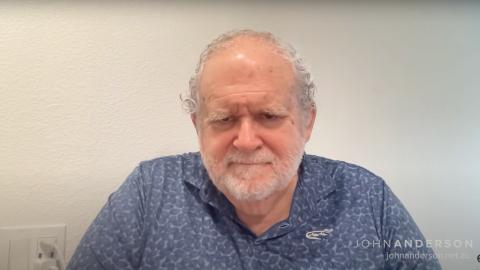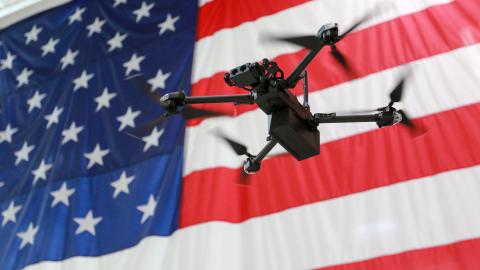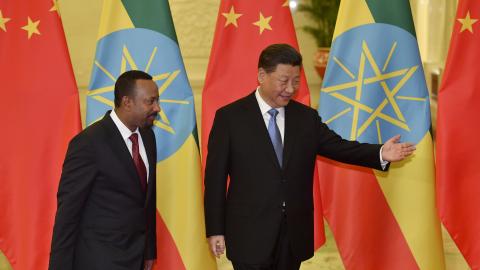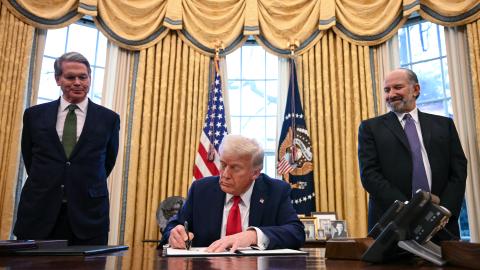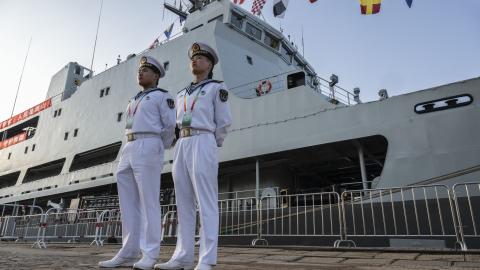
A Conversation with Eric Edelman and Mariah Sixkiller of the Commission on the National Defense Strategy


Senior Fellow and Director, Keystone Defense Initiative
Rebeccah L. Heinrichs is a senior fellow and director of the Keystone Defense Initiative. She specializes in US national defense policy with a focus on strategic deterrence.

Commissioner, Commission on the National Defense Strategy

Commissioner, Commission on the National Defense Strategy
The Commission on the National Defense Strategy released its bipartisan and unanimous report in July 2024. The commission concluded that the threats to American national security and interests are greater than at any time since World War II. The nature of the threats facing the United States also makes the security environment more complex than the Cold War.
For a discussion of the report and how the US can respond to these threats, join Commissioners Eric Edelman and Mariah Sixkiller and Hudson’s Rebeccah Heinrichs for this live event.
Event Transcript
This transcription is automatically generated and edited lightly for accuracy. Please excuse any errors.
Rebeccah L. Heinrichs:
Good morning, and welcome to this event at Hudson Institute. Welcome to those here with us in person, and for those listening online, my name is Rebeccah Heinrichs. I’m a senior fellow here at Hudson, and I’m the director of our Keystone Defense Initiative. And today we have two distinguished individuals here, one whom I’ve known for many years, and is a long time friend of mine. So, it’s a real pleasure to be able to have these two individuals here with us this morning to talk about a really critical development, really, of a bipartisan effort to explain the threats facing in the country, and what the United States needs to do to address them. We’re here to discuss the commission on the National Defense Strategy, and with me today I have Ambassador Eric Edelman, retired as a career minister from the US Foreign Service on May 1st, 2009.
He has been a practitioner, and residence at the Philip Merrill Center for Strategic Studies at the Johns Hopkins University School of Advanced International Studies, counselor at the Center for Strategic, and Budgetary Assessments, and a non-resident senior fellow at the Miller Center for Public Affairs, the University of Virginia. He co-chaired the National Defense Strategy Commission in 2017, 2018, and he was the vice chair of this particular commission. And so it’s a real pleasure to have him here. And with him we have Mariah Sixkiller, I said she has the best last name I’ve ever seen. She’s an executive at Hakluyt? Perfect, like chocolate, and company, a strategic advisory firm that helped clients navigate complex markets, and geopolitical challenges. Prior to that, in 2023, Mariah was general manager for Strategic Defense Affairs at Microsoft, and before that, a director on Microsoft’s national Security Government relations team.
It’s a pleasure to have both these individuals here to discuss this bipartisan important document, and to hear what they had to say. I know that they testified, Eric, you testified before Congress yesterday, so we’re going to start there. If you can just give us the highlights about this. There was eight commissioners appointed by the bipartisan bicameral leaders of the Senate, the House, the two Armed Services Committees. And so it’s a real honor to be here. I myself served on the Strategic Posture Commission, another bipartisan commission that came out right before this one. And so I think it’s really important to have this discussion today. So, Eric, if you can give us some highlights of the report.
Eric Edelman:
Happy to Rebeccah. First of all, thank you Rebeccah for hosting us, and having us here at Hudson. I’m particularly grateful that a Hudson senior fellow Walter Russell Mead took note of our report, and wrote a tremendous endorsement of it in his column in the Wall Street Journal, which I commend to everybody by the way, because he does a much better job than I’m about to do in summarizing our work. And let me say that first, there have been a series of these commissions to review the National Defense Strategy, or its predecessor, the Quadrennial Defense Review going back to 2010. For my sins, I’ve served on all of them, and as you said, I co-chaired the last one with former CNO Gary Roughead, and was the vice chair with former representative Jane Harmon on this one.
What these commissions are meant to do is give the Congress of the United States, in essence, an independent bipartisan second opinion on the National Defense Strategy produced by the Pentagon, which nests, as you know, under the National Security Strategy articulated by each administration. I can tell you that our work was truly bipartisan. It was a pleasure to work with all eight commissioners. These were eight patriotic Americans who all have different political views, but are all united by a commitment to first the important international role that the United States plays in the world, but second to the strongest possible defense of the United States. And I think because you mentioned your own service on the Strategic Posture Commission, that the two documents together actually, although we operated as you know, independently, although we did have the benefit of briefing from Senator John Kyle, and Madeline Creedon, your two co-chairs, the two documents, really, I think can, and probably should be read together because they complement each other Extremely well.
As a matter of fact, because you, and your colleagues had taken on the strategic nuclear issues, and some conventional as well, we were able to essentially endorse, and adopt your recommendations by incorporation without having to spend a lot of time ourselves working on those issues. But I think what we found was that the 19, or the 2022 National Defense Strategy that the Biden Administration published in the summer of 2022, which was largely written in 2021 before the Russian invasion of Ukraine, which shares a lot of commonality with the 2018 Trump Mattis National Defense Strategy is actually inadequate to the tasks that we actually face as a nation because of the growing threat from both the PRC, the ongoing challenge of Russian revanchism in Europe, the potential danger not only of North Korea but a Iran that’s moving rapidly towards nuclear latency, and beyond. And the intensifying cooperation among the four of them, that has confronted us with a situation, the likes of which we have not seen since 1945, really. And we cite former Secretary of Defense, Bob Gates, to that effect. And I think we agree with that judgment.
Mariah will have lots to add to this conversation. I think we found, just to give the top line notes, that if you look, and you can see some of the charts in our report about long term secular decline in defense spending, that the United States needs to spend more on defense, but just spending more on defense is not going to be adequate, because the program of record, and the procurement system we have in the Department of Defense in not keeping up with the pace of the military technological revolution that we’re seeing unfold in front of our eyes in Ukraine, and in Gaza, and Mariah can really speak to this, because she lives in this world. We have to do much more to bring the innovation, and rapid adaptation that the IT sector of our economy brings to the department, and to our weaponeering if we’re going to be able to meet this enormous challenge. And Mariah, I’ll just stop there, and let. . .
Rebeccah L. Heinrichs:
Actually let’s pick up from there. Let’s go, and then we’ll go into, we’ll talk more about the threats, and sort of on the next sweep of this, but Mariah, can you talk to us about the need to want just to go fast, how behind we are, and then on this technological piece, what do we have to do to take advantage of the innovation that we have? I know one of the points of your report is that we’ve got to do a better job at taking advantage of the developments in the private sector, too, for the purposes of defense. Kick us off there.
Mariah Sixkiller:
Thanks, Rebeccah. Eric kicked us off well. I think this is a key component of the report. Having worked in the business that was facing the defense department as a main customer, I can tell you they’re a tough customer in DC. Where we see success, and more rapid innovation adoption is usually outside the lines of the normal procurement system. So, you see the rush to help Ukraine, and people, frankly, breaking the norms of regulation, the norms of the procurement process to get systems that the Ukrainians need to defend their homeland. You see programs like DIU, which we as a commission strongly support, but funded at one billion dollars a teeny weeny dot something percentage of the entire DOD budget. We want to see those numbers go up. We want to see the procurement system shifting from a requirements-based system to a, what is the problem, and who can help me solve it?
And we’re open on what your technology looks like to do that. We think that will drive efficiency. We think that will potentially save service member lives as we move towards increasing automation. And frankly, it’s also related to what we talk a lot about in the report, which was at the heart of the strategy, which is integrated deterrence. What does integrated mean? Integrated, when we had our conversations with dozens, and dozens of leaders in the department, and around the world, and with friends, and allies, there was the sense of, I don’t know, I define that a certain way, and it wasn’t unanimous.
And so what we tried to do in this report was also say that integrated means whole of nation components outside DOD, but also the private sector. There’s a general sense that the average American citizen is not truly aware of the threat dynamic the US is facing right now. And that moving forward, we absolutely need to marshal all of the resources within American society beyond our traditional, and awesome fighting force, but even the guys that sit behind computers, and create solutions that will help save our warfighters, and help us win the mission moving forward.
Rebeccah L. Heinrichs:
Yeah, that’s great. No, that’s great. And I’ll even just this joint testimony with Chairwoman Harmon, and you, Eric says that quote, “DOD is operating at the speed of bureaucracy when the threat is approaching wartime urgency.” And then it went on, and said, programs like Replicator, and offices like the Defense Innovation Unit in the Office of Strategic Capital are great, but they are essentially efforts to work around the larger Pentagon systems, so we’ve created shortcuts for ourselves, but doesn’t that sort of get to the point that the entire Pentagon needs to move faster? And I think about. . . There are some bright spots of where the United States has been able to go fast, and deliver the Ukrainian something weapon systems quickly, and adapt them. So, how do we though? How do we take those models, and then make it larger for the entire department? Because it has to be bigger than the Secretary of Defense. It has to come from. . . How do we do this?
Eric Edelman:
I think that’s one of the conclusions, Rebeccah, that we also reached. So, to just go back to your initial point, we have created several different, I would say, pockets of innovation. DIU that Mariah just mentioned is one of them. And we applaud the work that Doug Beck has done. He’s been very creative, but as Mariah said, you’re talking about a billion dollars in a 850 billion defense budget. It’s not enough. There’s the strategic investment office, there’s the strategic capabilities office, there are other things Congress has done, the European Deterrence Initiative, the Pacific Security Initiative, all of these are testimony to how broken the system is because in order to accomplish our defense policy aims, we have to create institutions that work around the main frame of the institution.
And as you say, we can’t leave this all to the secretary, or the deputy secretary. I mean, we single out Deputy Secretary Kath Hicks for praise for the Replicator initiative. But Replicator, even if it’s wildly successful, will get at something like 10,000 attritables into the force, that’s great. But we’re watching on the battlefield in Ukraine where the Russians, and Ukrainians are literally deploying millions of these things, and the perspective conflicts that we might find ourselves in, hopefully not. And I want to come back to that in a minute because I think we share something with your Strategic Posture Commission that really bears emphasis. But if we get into a conflict in the Indo-Pacific, the consumption of munitions, it’ll be a different mix of munitions than what we’ve seen in Ukraine. But it is likely to be even astronomically larger just because of the scale, the geography, and the size of China’s military.
So we have to be able to do these things at scale, not just as science projects in the Department of Defense. And that’s going to take, I think, first, I think a recognition on the part of national leadership that this is an urgent need. And I think we are there with the leadership of the Committees of Jurisdiction. I think we certainly heard that from both Senator Reed and Ranking Member Wicker in the Senate when we testified in July. And I think we heard that yesterday from Chairman Rogers and Ranking member Adam Smith, both of whom I think share this sense of urgency.
But we have to have that at the national level, frankly, at the level of the president, the White House, and then in the leadership of the Department of Defense. And it needs to be not, as we just said, just the secretary and the deputy trying to. . . The job is too big to make them be the ones putting their finger on the, thumb on the scale for every program.
And let me just, if I could, come back to that one other point, which I think we share with your commission. One criticism that we ran into a little bit with the Congress, not so much, but some folks in the commentariat who read our report and criticized it, said, “You just guys want to throw more money at defense and you want to build forces to go to war. And if you build it, we’ll go to war.” This is not about that. This is about restoring America’s ability to deter conflict, which I think is the same approach that you and your colleagues took on the posture commission. We have to restore our ability to deter conflict because the cost of conflict will be infinitely higher than what it will cost us to try and prevent it.
Rebeccah L. Heinrichs:
Let’s stick with that point too. And Mariah, if you want to add to that, because that’s what we found on our commission is across the political spectrum in the United States, from the populists all the way to the traditional classical Reaganites to the central left Democrats, it seems like we are all desperate to avoid war. So that’s the big piece of this, but how do you do that? And your commission came to the same conclusion ours did, we’ve got to be better prepared, that’s the only way we’re going to avoid that. Can you talk about that and the bipartisan nature of that sentiment of what we have to do to prepare ourselves?
Mariah Sixkiller:
I think one piece we haven’t mentioned that is a key component of preparedness and the scaling that Eric has mentioned and the integrated goal that I talked about before is friends and allies. We can’t do this alone. Ukraine isn’t doing it alone, and we’re grateful to have the support that we’ve been able to provide to them and that so many European allies and others have provided to them, likewise for whatever future conflict we’re going to face first.
So we applaud in the report initiatives like AUKUS, which has extraordinary potential, but is going so slowly. And despite Congress working really hard and doing wonderful work to relax the ITAR regulations and other roadblocks to effective implementation of Pillar 2, it’s still costing the UK, for example, upwards of a billion dollars a year just to comply with the exemptions they have to seek in order to collaborate in earnest with us. So yes, progress being made, I don’t want to chagrin that. But would like to see more AUKUSes, would like to see expansion of AUKUS. This is a great model to address the question you posed, I think.
Rebeccah L. Heinrichs:
Right. So it’s not, to your point, Eric, so for critics who say, “Look, this is just another reason to throw more money the Department of Defense,” it’s actually no, there’s things that we can do that actually have nothing to do with money. It’s deregulation or it’s actually becoming more comfortable with tech sharing, the Pillar 2 of AUKUS.
Mariah Sixkiller:
Yep.
Rebeccah L. Heinrichs:
And that we have to, with a sense of urgency, look at all of these things we can do to get on the right side of the timeline because that’s where we’re sideways.
Well, let’s talk about the, I do want to talk, drill down a little bit more on the threat. Things are getting worse. It’s the collaboration, I think between and among these powers that has made the problem just so acute, China, Russia, and I’m going to stick with just those two right now. One of your points is that the force sizing construct in the NDS is inadequate for today’s needs and tomorrow’s challenges. We propose a multiple theater force construct with the joint force, in conjunction with US allies and partners, sized to defend the homeland and tackle simultaneous threats across the regions.
Why is that important? Why isn’t it, if China has the greatest capacity intent to dismantle the US Alliance architecture, why do we have to do it across these regions?
Eric Edelman:
It’s a great question and it’s one that obviously got a lot of attention. And as you know, there are some voices in this town that very powerfully argue that we really just need to focus on China. Everything else can take care of itself. And we talked to folks who espouse that view, I think it’s fair to say none of us were convinced by it.
There are a couple of pieces to it. One is that, to start where you began your question, the intensifying cooperation we’re seeing among these states, and I know you wanted to focus on Russia and China, but the reality is it’s North Korea and Iran as well because the bonds between these four are intensifying and becoming more intricate.
Just to give an example, Russia has been subjected to enormous punishing sanctions by the US and by other countries in the world, mostly Europe. There are obviously places that are leaky where they’re getting around it, but sanctions have had a huge impact on Russia, there’s no question about that. How has Russia been able to go on and, despite the enormous equipment losses that they’ve suffered in Ukraine, continue to fight the way they have and wreak death and destruction on the civilian population of Ukraine?
Well, it’s because they’re being largely financed by the People’s Republic of China, assisted by transfers of, first of all, some goods that are skirting US export controls that come in through China, but also provision of precision machining. That’s allowed the Russian defense industry to go on a three shift, 24 hour a day basis, wartime footing. When you add to that literally millions of shells, 152 rounds for Russian artillery from North Korea, thousands and thousands of drones provided by Iran, and a factory for drone production built by Iran in Russia. That’s how it’s worked.
So the reality is, much as we would like to say, “Well, all our theaters, all our combatant commands can operate in a stovepipe.” The world is interconnected. And it’s very hard to imagine, honestly, with this pattern going on, that a conflict that began, say, in the Indo-Pacific, let’s say over Taiwan or over the South China Sea or East China Sea, what have you. The idea that this would not very quickly metastasize into a global conflict is actually very hard to believe, in part because of the potential for opportunistic aggression by North Korea, by Iran, by Russia, or by China if something with Russia went even worse in Europe than we got going on now.
Your commission talked about extended nuclear deterrence. Mariah was talking about our allies. Our system of alliances has been, remains our huge comparative strategic advantage over these four malefactors of the world. And we need to have a strong nuclear deterrent to reassure them that we can defend them and will defend them with our nuclear deterrent. But they also have to see that we’re prepared to defend them all.
I want to stress that we do not suggest that the United States can do this fight all on its own, but what we have to have is the ability to provide a framework for allies. We need more out of allies, that’s for sure. And that’s across the board, whether it’s in Europe, in the Middle East or in the Pacific. But we have to have the framework and that’s going to involve some capabilities that only the US can provide. It’s going to be a different mix of forces in each theater because the theaters are all different in terms of what the requirements for fighting a war are.
But that means we’re going to have to have larger. . . The Army, Navy, Air Force are at historic lows in terms of the size of the force, both personnel and in equipment and force structure, and that’s going to have to increase. And that’s one of the reasons why we call for an increase in a top line, while at the same time saying we can’t just buy more of the same. It’s got to be a very different approach to procurement for what we need in the future.
Rebeccah L. Heinrichs:
I’m going to ask, I’m going to put two questions out there and you can pick which one you want to kind of go with here, Mariah. But Eric’s point about allies, I would actually even, I’ve tried to think of a more concrete way so we can conceptualize what we’re talking about defending rather than the rules-based order, the US-led order. I think most concretely, the concluding from our report and our study, it really is our military center of gravity is our ability to project power abroad and come to the defense of our allies. And the worst kinds of war, you think about on the highest levels of violence, nuclear conflict, that that’s going to start with a breakdown conventionally. It’s going to be these conventional regional wars.
So that’s why our adversaries are focusing, their theory of victory is focusing on breaking that. So that’s why allies, it’s not just this nice idea that allies are our advantage. That’s fundamentally true. It’s the US military center of gravity for what’s good for Americans here at home. So if you can talk about that and why we need allies then to be able to do this, whether it’s American delegation getting allies to do more, but we really do need allies if we’re going to navigate this peacefully and then win if deterrence does fail.
Then the other thing, we were talking about, Mariah, before we started our chat here, about the need for defense spending to continue, that these, a breakdown in appropriations and spending and predictability in the Department of Defense actually has compounding problems for getting on the right side of this. So either of those questions, if you want to take those.
Mariah Sixkiller:
Thanks, Rebecca. As a former congressional leadership staffer, I’ll take the second one because I’m best poised to answer.
It breaks my heart to see the breakdowns in Congress. I remember when it really works well. I started up there in 1999 and it’s, unfortunately, not working the way it used to. We used to pass the approps bills, there was a different number back then, but on time. We used to pass the NDAA, the National Defense Authorization Act on time for the fiscal year. And that’s just not happening anymore, and it’s really problematic.
I personally was elated to see the six-month CR fail yesterday, which would’ve been in the House, which would’ve been absolutely devastating for the Department of Defense. But I think it bears caution that more troubles are looming. I am hopeful the failure of that longer term CR will enable a shorter term CR and then revitalize negotiations on final bills, including FY ‘25 defense funding. But what we have looming, which I think people should be more aware of and talking about more, which Rebecca and I were discussing, is that the FRA, this Biden-McCarthy deal actually has another sequestration trigger that will come down like an ax on the federal government, and have horrific impacts at DoD with cuts up to 5percent and a baseline of FY-23, and that goes into effect April 30th of next year if Congress does not pass full year approps bills. So please tell people about this, this is very problematic, urge your members to get it together and negotiate a final bill. But this irregularity around funding for DoD is extraordinarily difficult for the department to do its job and to prepare in this complex threat environment.
Rebeccah L. Heinrichs:
It’s more expensive too in the end.
Mariah Sixkiller:
Correct.
Rebeccah L. Heinrichs:
A lot of people think that this is for the folks who are very rightfully concerned about defense or about just in general government spending, think that this is a way that’s going to save the US taxpayer dollars, it actually doesn’t.
Eric Edelman:
No, it costs more money, because you have to shove things to the right and then they become more expensive, because you’ve delayed it. So it’s got, as Mariah was saying, it’s got a . . . It’s a concatenation of troubles that afflict the department. And Secretary Mattis testified multiple times that one of the biggest threats that he thought the Department of Defensed was CRs. It wasn’t the Chinese, it was us. I want to get back though to your initial question, Rebeccah, because I agree very much with you that I think our adversaries are very much trying to undermine the credibility of US extended deterrence, both conventional and nuclear, particularly nuclear. You see that a lot with Putin’s nuclear threats and all of that.
We’ve had, as a nation, since the Second World War, a defacto national strategy that says we really want to fight forward, we want to have forward defense, be able, as you said, to project power, and fight an away game. We don’t want to fight a home game. And there’s still a lot of virtue in that, but it requires access, it requires our allies. And the allies also, there’s a lot of griping about the allies not doing enough, that’s absolutely right. They need to do more. And I applaud, I worked for the Secretary of Defense Bob Gates who constantly was exhorting the allies to do more, I applaud the work that was done in the Trump administration to get allies to do more. A lot of that’s continued I think in the Biden administration.
One of the things we have not talked about, but that we do point out in the report, is that President Putin’s invasion of Ukraine has actually thrown into relief and highlighted the fact that our defense industrial base is very fragile, very frail, and has a great deal of difficulty ramping up to meet demand. When you think about what we were talking about earlier, this emerging access for maligned powers causing enormous trouble all around the world, including, unlike the Cold War with one that has enormous productive capacity, which is China, we’re not going to be able to do this all on our own.
We’re going to have to have allies producing as well, and if anything, if you look at our European allies for instance, their defense industrial base is in even worse shape than ours is. But it’s interesting, Europeans are beginning to wake up. Mario Draghi just proposed a big reform plan for the EU that includes a proposal for a trillion euros in investment in defense industry. When’s the last time we heard the Europeans talking about that? So we need to encourage that, we need to work with our allies to get them to produce more. There are synergies I think with our partners who are not technically treaty allies in the Middle East, but with whom we have important security interests. And obviously we’ve talked already about AUKUS and what we’re doing there. We’ve got to find more ways to get allies engaged and involved.
Rebeccah L. Heinrichs:
One of the things I found too is that our allies, so they’re in a little bit of a dilemma, if they . . . And it’s more acute depending on which ally you’re talking to, but if they know that the United States is committed to staying in the region, to pushing and helping delegate across alliances, you can pick your region, then they are willing to do more. But if they start to get nervous that the United States is pulling away, then you actually start to see more disfunction and people beginning, I would say necessarily hedging, but a little bit of hedging for the countries that are most vulnerable. So I do worry about that, that it requires both strong US commitment to the region, and also leaning hard on our allies to do more.
I want to talk about the Middle East, because this is just . . . I think it’s a powder keg. Israel is really in a fight for its life here, and you see these Iranian proxies around the region. So what is Iran . . . Iran, to me Iran’s trying to push the United States out of the region. And I can see pressure inside the United States, we’re saying, “Look, the US has forces in the region, maybe it’s time that the US left the Middle East.” How would you respond to that with the commission for what the United States is trying to do to support Israel, but in larger the stability of the Middle East?
Eric Edelman:
I think what happened in April is certainly a validation, first of all, of what Central Command has been trying to do for years, going back to my time in government in the Bush 43 administration, which is to build a system of shared early warning to deal with the potential of Iranian attacks against countries with whom we are tied. And I think we had, when I was undersecretary, we had 250,000 US forces in the CENTCOM AOR, I think we’re now down to like 40 or something. And a lot of those are at sea, either in the Fifth Fleet off by Raynor and in the Red Sea.
What I think, we’ve got a very capable alley in Israel in terms of innovation, defense production, we’ve got partners in the Gulf states who have a lot of money. There’s an obvious synergy there. What was done in April where essentially you had, as you know, the largest most complex missile ballistic crews and UAV attack ever, but thwarted by a framework created by the United States, organized by the United States. So I think that’s the kind of thing, we didn’t really flesh this out in our report, but I think that really is the idea of our multi-force construct.
It’s not that you need hundreds of thousands of boots on the ground everywhere, but you do have to have some of the unique capabilities that we bring to organize for ISR, intelligence, surveillance, recognizance, being able to fuse all that data, being able to disseminate it to partners and allies and then be able to act on it collectively. They can’t do that on their own, only we can help them do that. But we can leverage lots of things they’re doing with our own investment and our own presence.
Rebeccah L. Heinrichs:
And presence, it requires . . . It actually doesn’t require the same force levels, it does require the United States to be forward deployed and to be there.
Eric Edelman:
And for them to know, as you say, that we’re going to be there and we’re not going to say, “Well, we get tired of this place. Now we’re leaving.” Because they still have to live there.
Rebeccah L. Heinrichs:
Well, they still have to live there, but also I keep thinking about just the . . . I want to talk about integrated deterrence, because I think this is . . . It requires at the top of the level of US political leadership to get the State Department exercising public diplomacy with our allies, but to rack and stack what’s actually the priority. And right now the Iranians, through their proxies, they’re trying to close down the US commitment to provide free and open international waters. The Red Sea is essentially closed down to European and American cargo shipping. They let the Chinese and the Russian flagged ships through the Red Sea, but the Houthis are attacking anything that’s Western flagged.
So if you could just talk a little bit more about this idea of integrated deterrence and why this requires . . . Because I do think as soon as you start to press people even privately, they say, “Look, you’ve got all these commissions saying this is the number one threat, this is the number one problem that the United States has to deal with.” But then you say, “Okay, that means we’re going to have to not maybe . . . “ If everything’s a priority, nothing’s a priority. So how do you get Treasury and the State Department and private sector to focus on this and to collaborate in a way that’s effective? Or maybe not how to do it, but maybe just the importance of doing that.
Mariah Sixkiller:
Yeah. This was a key point in channeling our esteemed Chair Jane Harman, one of the points she drove home yesterday in her testimony was indeed on this, in the sense that whole of nation and whole of government does imply a much more stepped up and coordinated role for State and AID and agencies like Commerce and Treasury, and even the Department of Education and others. One way to achieve that integration, which has historically been challenging for this government, which is very siloed, let’s all admit it, is to stop thinking about the National Defense Strategy as a DoD document, and to stop having it reviewed by the committees of jurisdiction that only look at DoD, but rather expand this truly to an integrated national strategy document. That gives us an opportunity to talk about the role of these other agencies. I’m sure Eric, as a former longtime State Department professional, has some thoughts on that too.
Eric Edelman:
I’ll pass . . . Well, the point I would just add to what Mariah said, all of which I agree with, is a couple of points. One is that particularly the Chinese, who are the pacing challenge that everyone agrees with, clearly have a whole of society approach. They have an approach that they call Comprehensive National Power that tries to bring into the fight just literally everything that Chinese society can throw at it. They have, because it’s a command economy still, well, it’s a weird hybrid, but it’s a market economy guided and controlled by a Communist Party, they have civil military fusion. So they can direct the private sector to provide certain kind of technologies for their military.
The challenge we have I think, as a nation, is that we have a form of government that was contrived to prevent this from happening. To prevent the concentration of political and economic power for good and sufficient reasons. We don’t want to give that up. But we also now are in a situation where we really have to bring to bear more effectively the elements of national power. That takes I think, from the get-go, it starts with presidential leadership understanding the problem, articulating it to the public, and then organizing the government to do it. And it goes way beyond, I would say, just the traditional national security elements of the government, the Department of State, intelligence agencies, DoD obviously, NSC, et cetera.
Obviously Treasury is playing a big part in this now for a variety of reasons, Commerce, the whole idea of having a small yard high fence to protect small nanometer chips from getting to China so that we can preserve our qualitative, industrial advantage over China. I would even say the much maligned Department of Education.
We face a challenge as a nation, and I know you know this, Rebeccah, from your work on the Strategic Posture Commission. Why is the ground-based strategic deterrent Sentinel system in a Nunn-McCurdy Breach? Is it because the main contractor, Northrop Grumman, can’t build an intercontinental ballistic missile or solid rocket motor on time and on budget? No, that’s not what’s holding it up. What’s holding it up is a variety of things, but one is a whole panoply of regulations that didn’t exist when we’re putting manned missiles in the upper Midwest and the Plains States in the 1960s that we now have to figure out how do we deal with that.
But also we lack the people who know how to pour the specialized reinforced concrete that has to go into silos and command centers. We lack electricians, welders. This is a problem in the submarine industrial base as well.
So we have to take this on as a nation and understand that not everybody needs to get four-year college education and get lots of debt to live with for the rest of their lives. We can use, as we discovered in our work, Pell Grants to fund people to do vocational apprenticeships and learn a good trade that will provide Americans with good high-skilled jobs that have traditionally been the backbone of our middle class and of our economy.
Rebeccah L. Heinrichs:
Yeah, I would tell people that if there is going to be a Build Back Better in the next administration, it should be focused on the defense industrial base, that that is something that I hope that we can all agree on for a variety of reasons.
I do want to talk . . . We’re starting to run out of time. I do want to talk about the vulnerability of the US Homeland. So we’ve talked about the importance of extending power abroad and our alliance architectures being broken, or potentially being threatened to be broken. But you mentioned . . . I’m going to stick with China here because we just have to . . . Just for the sake of scoping.
China’s cyber capability, space assets, growing strategic forces, and fully modernized conventional forces are designed to keep the United States, got it, out of Taiwan or South or East China Seas. But China has infiltrated our critical infrastructure networks to prevent or deter US action by contesting our logistics, disrupting power and water, and otherwise remove the sanctuary that the United States has long enjoyed at home.
So there’s a broader question, and we’d struggled with this too in our report. You want to grab the American people’s attention. You want them to know how bad things are. You don’t want to give comfort to the adversary that we are very weak, so you have to walk this line. We can still defend ourselves, but we’re not in a great spot, so we have to galvanize support.
So you talk about the Homeland, the vulnerabilities of the Homeland, and then just how you navigate it, because you’ve gotten a little bit of criticism, I’ve seen a little stray fire, and we did too, for advertising American weakness. I don’t know if either one of you want to tackle that.
Mariah Sixkiller:
Go ahead, Eric.
Rebeccah L. Heinrichs:
Okay.
Eric Edelman:
One of our commissioners is General Jack Keane. General Keane, I think, is, on this issue, the wisest person I’ve heard. He basically says we have to treat the American people like adults and not sugarcoat things for them or make everything seem like it’s all great.
Yes, we have . . . It is a fact. We have the best, most battle-tested military in the world. We have the most innovative economy in the world. Our economy is leading the world post-COVID. So all of that is true, but we also have neglected our defense, and that is a bipartisan problem.
It’s been both parties, across administrations of both parties. Congress is controlled by both parties. We are now in a circumstance, for all the reasons we’ve already discussed this morning, where that is no longer acceptable if we want to continue to play the role that we have traditionally played in the world, organizing an alliance of free democratic nations to resist aggression by authoritarian regimes.
We faced many crises in the past, and I think . . . Mariah will correct me if I’m misstating what I think we all agree on. But, traditionally, historically, when we have faced circumstances like this, what has ended up mobilizing Americans has been a catastrophe, whether it’s Pearl Harbor or Task Force Smith in the Korean War or 9/11.
Mariah Sixkiller:
9/11.
Eric Edelman:
What we hope is that we can use this crisis, which is a real one, the largest land war in Europe since World War II, a pretty big war in the Middle East that looks like it could escalate even further, to get the American people’s attention and say we really have to get serious about this now, because, as we said earlier, the cost of conflict will be infinitely . . . And we try to quantify that in our report. Will be infinitely higher than what it will cost us to try and prevent this from happening.
Mariah Sixkiller:
Eric, honestly, said exactly what I was going to. Just briefly, we have to disrupt the complacency of the American people. I don’t think they have any idea the threats we are facing in this current dynamic.
I agree with Eric and I think we’ve earned our cynicism that it often takes direct impact and suffering, whether it’s 9/11 or any of the other events Eric referred to, to force change and to force a sense of ownership of our security. But at this point, the complacency that we sense across the US is a very dangerous thing that is not helping to motivate the people in Washington who speak for them to do the right thing on the defense budget and a number of other matters. We are hoping to use this report to change that.
Rebeccah L. Heinrichs:
Well, I appreciate that. I think we’ve got time for just maybe one question from the audience, if somebody has a burning question in . . . We have one here.
Morten Hipschman:
Yes. Hi. Thank you, commissioners, for this very interesting report and your comments today. My name is Morten Hipschman. I’m a visiting researcher at Georgetown University. You mentioned in your report and your statements here today that European allies, for example, needs to re-up their industrial defense industrial base.
For the past few administrations, less so in the current one, there’s been a resistance to the integration of the EU defense from the US, not necessarily out in the open but sometimes such as during the Trump administration. The EU now imports up to 65percent of its defense material from the US. Should the US endorse a EU defense industrial integration that would up their defense industrial base, even if it commits to trade-offs to the industrial base of the US and the exports here?
Eric Edelman:
There’s no question that there are going to be problems that we’ll have to manage in all of this. I think the US concern . . . As someone who spent some time on EU-NATO issues in his career, I think our concern has never been that we don’t want Europeans to do more for defense. We’ve always wanted them to do more for defense. Our concern has been we don’t want them to do . . .
And it’s a little easier now because for a long time we had a mismatch between membership in the EU and in NATO. With the addition of Finland and Sweden now, really there’s much more congruence. I mean you have a few outliers like Austria and Ireland, but, in essence now, they’re more congruent.
But what we didn’t want was duplication and wasted effort. I still think that’s a good thing to try and avoid, but I think we have to encourage more transatlantic defense cooperation. Yes, there’re going to be times when US and European companies are going to be competing for contracts.
Right now, I think the need is so great that . . . I think we’re not there yet where we have to worry about that, but at some point we may have to. But right now I think there’s plenty for everybody to do because, I mean, if you just look at the yawning needs for resupply, given the drawdowns that we and our European allies have done of stocks for Ukraine, there’s plenty for everybody to produce right now.
Rebeccah L. Heinrichs:
Yeah. One thing . . . If I could I just add to that. When you take an audit of everything that we need to do it really since the Cold War, we have had an atrophying of the defense industrial base across the west. So it’s our allies as well as the United States. At the same time, we’ve increased regulations, so decreased defense investments, especially to deter major power conflicts. We can do low-intensity stuff a little better. We don’t have the ability to produce things at scale and quickly while we’ve increased regulations.
Then I think of a lot of the obstacles we put for tech sharing between allies. That’s a luxury thing that we have at a time of much greater peace and stability. We don’t have that kind of luxury, and so there needs to be greater collaboration.
Eric Edelman:
To your point, Rebeccah, I mean one of the things we ran into when we talked to former Secretary Esper, and one of the things that was driving him crazy both as secretary of the Army and as secretary of defense, is we’re moving towards an era of autonomy, AI, robotics, et cetera, and yet in our own internal requirements and testing processes, we have to make sure that the unmanned aircraft would be safe for a pilot, even though there’s never going to be a pilot in this aircraft. What kind of . . . It’s meant to be attritable. It’s meant to be cheap and something you can lose. So why do we tie our shoelaces together in order to do that?
Rebeccah L. Heinrichs:
Well, and this is why our adversaries, in this information warfare that they’re engaged in, are trying to send the message that democracy and open societies, democratic republicanism, it’s not as good as theirs because we are an open society and it requires buy-in and consensus and work. Our effort then or the task before us is to make these changes because we do have a better system. Our system is better for human flourishing and for the American people. And so, it’s our job now to look at those things that we have in place and fix them quickly. We can do it.
And so, if I can just close out. For those at home, these are the two reports that I would just commend to those watching at home. These are meant to be read by everyday Americans. This is for you. The people here are still sovereign. And so, it’s going to be up to the American people to understand this and then support their members of Congress and public officials to do the right thing in a bipartisan manner.
And so, thank you so much for this great, important work that you’ve done for this report. It was a real privilege to have you here today. Please join me in thanking the two commissioners.
Eric Edelman:
Thank you.

The Hudson Institute Political Studies Policy Certificate Program gathers talented early career professionals for advanced study of American foreign and domestic policy and national security, led by policy experts and experienced government officials.
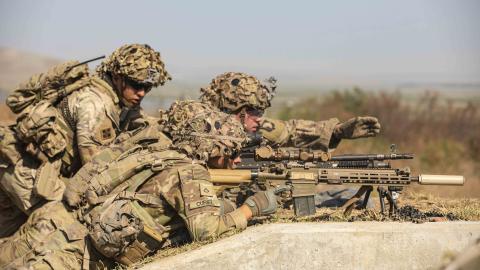
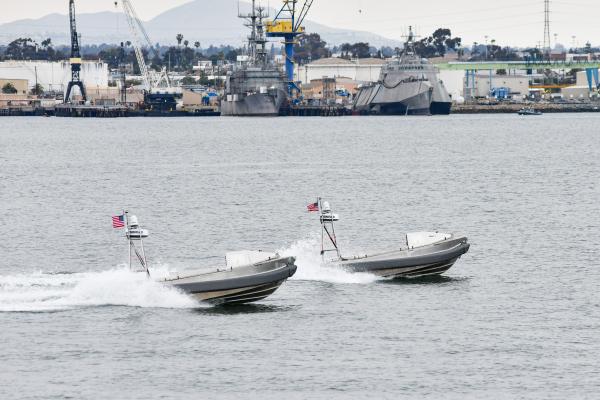
At Sea Air Space 2025, Senior Fellows Bryan Clark and Timothy A. Walton will discuss their findings with a panel of government and industry experts tasked with implementing these ideas.
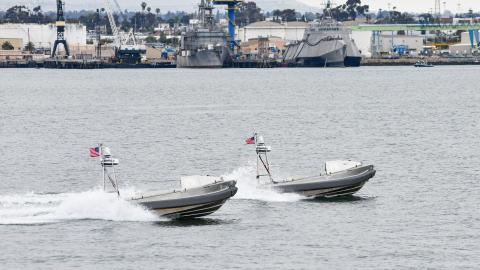

Join Hudson for a discussion on European Union and United Kingdom competition and regulatory authorities’ increasing focus on digital platforms.


Join Hudson Institute for a panel discussion examining the potential scenarios for Mexico and the future of the US-Mexico relationship.

